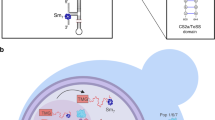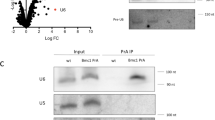Abstract
Although the catalytic subunit of the Schizosaccharomyces pombe telomerase holoenzyme was identified over ten years ago, the unusual heterogeneity of its telomeric DNA made it difficult to identify its RNA component. We used a new two-step immunoprecipitation and reverse transcription–PCR technique to identify the S. pombe telomerase RNA, which we call TER1. TER1 RNA was 1,213 nucleotides long, similar in size to the Saccharomyces cerevisiae telomerase RNA, TLC1. TER1 RNA associated in vivo with the two known subunits of the S. pombe telomerase holoenzyme, Est1p and Trt1p, and neither association was dependent on the other holoenzyme component. We present a model to explain how telomerase introduces heterogeneity into S. pombe telomeres. The technique used here to identify TER1 should be generally applicable to other model organisms.
This is a preview of subscription content, access via your institution
Access options
Subscribe to this journal
Receive 12 print issues and online access
$189.00 per year
only $15.75 per issue
Buy this article
- Purchase on Springer Link
- Instant access to full article PDF
Prices may be subject to local taxes which are calculated during checkout







Similar content being viewed by others
References
Legassie, J.D. & Jarstfer, M.B. The unmasking of telomerase. Structure 14, 1603–1609 (2006).
Theimer, C.A. & Feigon, J. Structure and function of telomerase RNA. Curr. Opin. Struct. Biol. 16, 307–318 (2006).
Vega, L.R., Mateyak, M.K. & Zakian, V.A. Getting to the end: telomerase access in yeast and humans. Nat. Rev. Mol. Cell Biol. 4, 948–959 (2003).
Cooper, J.P., Nimmo, E.R., Allshire, R.C. & Cech, T.R. Regulation of telomere length and function by a Myb-domain protein in fission yeast. Nature 385, 744–747 (1997).
Pitt, C.W., Valente, L.P., Rhodes, D. & Simonsson, T. Identification and characterization of an essential telomeric repeat binding factor in Schizosaccharomyces pombe. J. Biol. Chem., published online 7 October 2007 (doi:10.1074/jbc.M708784200).
Nakamura, T.M. et al. Telomerase catalytic subunit homologs from fission yeast and human. Science 277, 955–959 (1997).
Baumann, P. & Cech, T.R. Pot1, the putative telomere end-binding protein in fission yeast and humans. Science 292, 1171–1175 (2001).
Baumann, P. & Cech, T.R. Protection of telomeres by the Ku protein in fission yeast. Mol. Biol. Cell 11, 3265–3275 (2000).
Zappulla, D.C. & Cech, T.R. Yeast telomerase RNA: a flexible scaffold for protein subunits. Proc. Natl. Acad. Sci. USA 101, 10024–10029 (2004).
Dandjinou, A.T. et al. A phylogenetically based secondary structure for the yeast telomerase RNA. Curr. Biol. 14, 1148–1158 (2004).
Chen, J.L. & Greider, C.W. An emerging consensus for telomerase RNA structure. Proc. Natl. Acad. Sci. USA 101, 14683–14684 (2004).
Lin, J. et al. A universal telomerase RNA core structure includes structured motifs required for binding the telomerase reverse transcriptase protein. Proc. Natl. Acad. Sci. USA 101, 14713–14718 (2004).
Hiraoka, Y., Henderson, E. & Blackburn, E.H. Not so peculiar: fission yeast telomere repeats. Trends Biochem. Sci. 23, 126 (1998).
Seto, A.G., Zaug, A.J., Sobel, S.G., Wolin, S.L. & Cech, T.R. Saccharomyces cerevisiae telomerase is an Sm small nuclear ribonucleoprotein particle. Nature 401, 177–180 (1999).
Jady, B.E., Bertrand, E. & Kiss, T. Human telomerase RNA and box H/ACA scaRNAs share a common Cajal body-specific localization signal. J. Cell Biol. 164, 647–652 (2004).
Lin, J.J. & Zakian, V.A. An in vitro assay for Saccharomyces telomerase requires EST1. Cell 81, 1127–1135 (1995).
Seto, A.G., Livengood, A.J., Tzfati, Y., Blackburn, E.H. & Cech, T.R. A bulged stem tethers Est1p to telomerase RNA in budding yeast. Genes Dev. 16, 2800–2812 (2002).
Zhou, J., Hidaka, K. & Futcher, B. The Est1 subunit of yeast telomerase binds the Tlc1 telomerase RNA. Mol. Cell. Biol. 20, 1947–1955 (2000).
Fisher, T.S., Taggart, A.K. & Zakian, V.A. Cell cycle-dependent regulation of yeast telomerase by Ku. Nat. Struct. Mol. Biol. 11, 1198–1205 (2004).
Haering, C.H., Nakamura, T.M., Baumann, P. & Cech, T.R. Analysis of telomerase catalytic subunit mutants in vivo and in vitro in Schizosaccharomyces pombe. Proc. Natl. Acad. Sci. USA 97, 6367–6372 (2000).
Beernink, H.T., Miller, K., Deshpande, A., Bucher, P. & Cooper, J.P. Telomere maintenance in fission yeast requires an Est1 ortholog. Curr. Biol. 13, 575–580 (2003).
Maxwell, E.S. & Fournier, M.J. The small nucleolar RNAs. Annu. Rev. Biochem. 64, 897–934 (1995).
Greider, C.W. & Blackburn, E.H. A telomeric sequence in the RNA of Tetrahymena telomerase required for telomere repeat synthesis. Nature 337, 331–337 (1989).
Shippen-Lentz, D. & Blackburn, E.H. Functional evidence for an RNA template in telomerase. Science 247, 546–552 (1990).
Hedges, S.B. The origin and evolution of model organisms. Nat. Rev. Genet. 3, 838–849 (2002).
Froussard, P. A random-PCR method (rPCR) to construct whole cDNA library from low amounts of RNA. Nucleic Acids Res. 20, 2900 (1992).
Lue, N.F. & Peng, Y. Identification and characterization of a telomerase activity from Schizosaccharomyces pombe. Nucleic Acids Res. 25, 4331–4337 (1997).
Nakamura, T.M., Cooper, J.P. & Cech, T.R. Two modes of survival of fission yeast without telomerase. Science 282, 493–496 (1998).
Nimmo, E.R., Pidoux, A.L., Perry, P.E. & Allshire, R.C. Defective meiosis in telomere-silencing mutants of Schizosaccharomyces pombe. Nature 392, 825–828 (1998).
Croy, J.E., Podell, E.R. & Wuttke, D.S. A new model for Schizosaccharomyces pombe telomere recognition: the telomeric single-stranded DNA-binding activity of Pot11–389. J. Mol. Biol. 361, 80–93 (2006).
Teixeira, M.T., Arneric, M., Sperisen, P. & Lingner, J. Telomere length homeostasis is achieved via a switch between telomerase-extendible and -nonextendible states. Cell 117, 323–335 (2004).
Sugawara, N.F. DNA Sequences at the Telomeres of the Fission Yeast S. pombe. Thesis, Harvard (1989).
Zaug, A.J., Linger, J. & Cech, T.R. Method for determining RNA 3′ ends and application to human telomerase RNA. Nucleic Acids Res. 24, 532–533 (1996).
Stellwagen, A.E., Haimberger, Z.W., Veatch, J.R. & Gottschling, D.E. Ku interacts with telomerase RNA to promote telomere addition at native and broken chromosome ends. Genes Dev. 17, 2384–2395 (2003).
Livengood, A.J., Zaug, A.J. & Cech, T.R. Essential regions of Saccharomyces cerevisiae telomerase RNA: separate elements for Est1p and Est2p interaction. Mol. Cell. Biol. 22, 2366–2374 (2002).
Chappell, A.S. & Lundblad, V. Structural elements required for association of the Saccharomyces cerevisiae telomerase RNA with the Est2 reverse transcriptase. Mol. Cell. Biol. 24, 7720–7736 (2004).
Hofacker, I.L. Vienna RNA secondary structure server. Nucleic Acids Res. 31, 3429–3431 (2003).
Seto, A.G. et al. A template-proximal RNA paired element contributes to Saccharomyces cerevisiae telomerase activity. RNA 9, 1323–1332 (2003).
Xayaphoummine, A., Bucher, T. & Isambert, H. Kinefold web server for RNA/DNA folding path and structure prediction including pseudoknots and knots. Nucleic Acids Res. [online] 33, W605–W610 (2005).
Dandekar, T. & Tollervey, D. Mutational analysis of Schizosaccharomyces pombe U4 snRNA by plasmid exchange. Yeast 8, 647–653 (1992).
Tzfati, Y., Fulton, T.B., Roy, J. & Blackburn, E.H. Template boundary in a yeast telomerase specified by RNA structure. Science 288, 863–867 (2000).
Lundblad, V. & Szostak, J.W. A mutant with a defect in telomere elongation leads to senescence in yeast. Cell 57, 633–643 (1989).
Reichenbach, P. et al. A human homolog of yeast Est1 associates with telomerase and uncaps chromosome ends when overexpressed. Curr. Biol. 13, 568–574 (2003).
Snow, B.E. et al. Functional conservation of the telomerase protein Est1p in humans. Curr. Biol. 13, 698–704 (2003).
Hughes, T.R., Evans, S.K., Weilbaecher, R.G. & Lundblad, V. The Est3 protein is a subunit of yeast telomerase. Curr. Biol. 10, 809–812 (2000).
Fisher, T.S. & Zakian, V.A. Ku: a multifunctional protein involved in telomere maintenance. DNA Repair (Amst.) 4, 1215–1226 (2005).
Mozdy, A.D. & Cech, T.R. Low abundance of telomerase in yeast: implications for telomerase haploinsufficiency. RNA 12, 1721–1737 (2006).
Rautio, J. et al. Sandwich hybridisation assay for quantitative detection of yeast RNAs in crude cell lysates. Microb. Cell Fact. [online] 2, 4 (2003).
Leonardi, J., Box, J.A., Bunch, J.T. & Baumann, P. Nat. Struct. Mol. Biol., advance online publication xxx 2007 (doi:10.1038/nsmb1343).
Feldmann, H. & Winnacker, E.L. A putative homologue of the human autoantigen Ku from Saccharomyces cerevisiae. J. Biol. Chem. 268, 12895–12900 (1993).
Boulton, S.J. & Jackson, S.P. Components of the Ku-dependent non-homologous end-joining pathway are involved in telomeric length maintenance and telomeric silencing. EMBO J. 17, 1819–1828 (1998).
Manolis, K.G. et al. Novel functional requirements for non-homologous DNA end joining in Schizosaccharomyces pombe. EMBO J. 20, 210–221 (2001).
Peterson, S.E. et al. The function of a stem-loop in telomerase RNA is linked to the DNA repair protein Ku. Nat. Genet. 27, 64–67 (2001).
Feng, J. et al. The RNA component of human telomerase. Science 269, 1236–1241 (1995).
Singer, M.S. & Gottschling, D.E. TLC1: template RNA component of Saccharomyces cerevisiae telomerase. Science 266, 404–409 (1994).
McEachern, M.J. & Blackburn, E.H. Runaway telomere elongation caused by telomerase RNA gene mutations. Nature 376, 403–409 (1995).
Kanoh, J. & Ishikawa, F. Composition and conservation of the telomeric complex. Cell. Mol. Life Sci. 60, 2295–2302 (2003).
Sugimoto, N., Nakano, M. & Nakano, S. Thermodynamics-structure relationship of single mismatches in RNA/DNA duplexes. Biochemistry 39, 11270–11281 (2000).
Sabourin, M., Tuzon, C.T., Fisher, T.S. & Zakian, V.A. A flexible protein linker improves the function of epitope-tagged proteins in Saccharomyces cerevisiae. Yeast 24, 39–45 (2007).
Miller, K.M. & Cooper, J.P. The telomere protein Taz1 is required to prevent and repair genomic DNA breaks. Mol. Cell 11, 303–313 (2003).
Acknowledgements
We thank P. Baumann for sharing results before publication and J.B. Boulé, M. Mateyak, J. Phillips, S. Pinter, M. Sabourin, C. Tuzon and Y. Wu for critical reading of the manuscript. We thank O. Troyanskya and C. Huttenhower for computational assistance, R. Allshire (Wellcome Trust Centre for Cell Biology), P. Baumann (Stowers Institute for Medical Research), H. Lieberman (Columbia University) and M. Sipiczki (University of Debrecen) for strains, and K. Miller in J. Cooper's lab, C. Tuzon and J. Bruzik for protocols. This work was supported by US National Institutes of Health grants GM43265 and R37 GM26938 and by a US National Research Service Award to C.J.W.
Author information
Authors and Affiliations
Corresponding author
Supplementary information
Supplementary Text and Figures
Supplementary Figures 1–6, Supplementary Table 1 (PDF 507 kb)
Rights and permissions
About this article
Cite this article
Webb, C., Zakian, V. Identification and characterization of the Schizosaccharomyces pombe TER1 telomerase RNA. Nat Struct Mol Biol 15, 34–42 (2008). https://doi.org/10.1038/nsmb1354
Received:
Accepted:
Published:
Issue Date:
DOI: https://doi.org/10.1038/nsmb1354
This article is cited by
-
The methyl phosphate capping enzyme Bmc1/Bin3 is a stable component of the fission yeast telomerase holoenzyme
Nature Communications (2022)
-
LARP7 family proteins have conserved function in telomerase assembly
Nature Communications (2018)
-
Pof8 is a La-related protein and a constitutive component of telomerase in fission yeast
Nature Communications (2018)
-
LARP7-like protein Pof8 regulates telomerase assembly and poly(A)+TERRA expression in fission yeast
Nature Communications (2018)
-
Eroded telomeres are rearranged in quiescent fission yeast cells through duplications of subtelomeric sequences
Nature Communications (2017)



